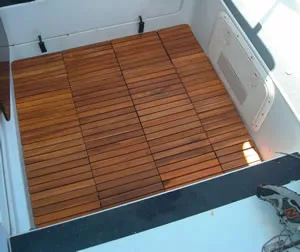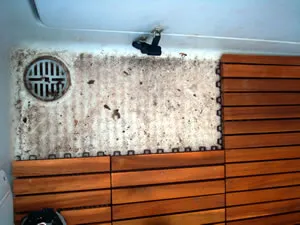

The typical production sailboat comes with a molded fiberglass tub for a cockpit well, complete with an uncleanable nonskid sole. It looks dirty an hour after cleaning and debris grates under foot. Some boat owners install Dri-Deck or something similar, which can be torture to barefeet and makes the cockpit look like a shower stall. A more attractive option is beautiful owner-built teak grating; unfortunately, fabricating one of these requires considerable effort and skill. We found a more practical solution for us non-carpenters: do-it-yourself decking that costs about $7 per square foot and takes about an hour to install. The DIY Patio Deck company sells pre-assembled, snap-together tiles that resemble traditional grating. For our test boat, we chose eight-slat acacia plantation hardwood exterior tiles; many wood types and styles are available.
The tiles have been living on our test boat for three years, enduring sun and rain, sandy feet, and bleeding fish, without rotting, staining, or splintering. They were installed in an hour without angst, great skill, or a truck full of tools.
The wood sections came with low-quality plated screws, so we replaced them with more marine-worthy half-inch brass screws; using a cordless driver, the swap went quickly. Also, the tiles needed to be trimmed to size, and we beveled the edges to accommodate the curve of the cockpit well corners. The tiles plastic support grids are flexible, and the spacers allow for water drainage, filtering debris, and reducing cockpit-drain clogs. Once installed, the tiles can be rolled up for cleaning.
Gorgeous when first installed, the acacia tiles are like any wood product in the marine environment: After a few years, you will need to either refinish them or accept natural graying as you would with teak. The primary limitations of the snap-together wood tiles are that the snaps are only strong enough to hold them together if the edges are constrained; in a cockpit, there is nothing to hold them down but gravity. We only recommend these for areas that are fully bounded; a stick-built solution is required for more open areas.
Bottom line: The DIY Patio Deck wood tiles are much cooler on the feet than nonskid, easier on the knees, and simple to install. At $6.45 per 12-inch tile square, they are a suitable, budget-friendly upgrade for the casual DIYer.

Not too long ago, well-known paint maker Awlgrip launched its first-ever wood coating system, Awlwood MA. Awlgrip, an Akzo Nobel brand, has always been a favorite among topside-paint professionals, and in PSs topside paint tests (see PS December 2012 online), so we were eager to see how its new exterior wood clear finish stacks up to top picks from our long-term wood coatings test (see PS September 2011 online).
The new coating system, Awlwood MA, includes a primer, reducer, and clear gloss that its maker claims offers serious flexibility, and excellent toughness and abrasion resistance. According to Awlgrip, the varnish will keep its original look and level of protection for multiple seasons. The best part, however, is that ease of application isn’t sacrificed to achieve lasting performance, as it often is when applying two-part varnishes.
The fast-curing Awlwood MA allows multiple applications per day, without sanding between building coats, provided the previous coat is sufficiently cured. It can be applied by brush, by rolling and tipping, and by spraying, over a wide temperature and humidity range.
To see if the Awlwood MA lives up to the hype, we applied it to a panel of older teak that had been sanded bare, for a long-term, head-to-head comparison with Interluxs Sikkens Cetol Natural, a top varnish alternative in past tests. For field tests, we also applied it to the wood trim aboard a Florida-based Mako 21.
So far, the system has met its easy-application claims. Testers noted that it flowed well when brushed on and that it dried to the touch in about two hours. We used no reducer and applied the coating in temperatures ranging from 70- to 75-degrees, with moderate humidity and sunshine.
Stay tuned for the long-term durability test report and for the launch of a new round of varnish testing.

When we last reviewed dehumidifiers (see Practical Sailor June 2013 online), we recommended the Eva-Dry EDV-2200 for drying out small to medium (non-liveaboard) boats-which encompasses most recreational-boat owners. It was also the Best Choice pick for drying out a damp boat.
Weve been running that thermo-electric Eva-Dry for eight hours a day for nearly three years, allowing the water to drain into the boats sink. Yes, it freezes in the winter cold, but generally thaws during the day-time rest cycle, and no damage has occurred. Thermo-electric dehumidifiers operate without moving parts, other than a small fan to move air past the cold plate.
When we bought the unit years ago, it was $46; now, its common to see it priced at about $100. The price hike motivated us to seek out a comparable alternative that is economical, widely available, and effective. We settled on the Perfect Home 4-pint dehumidifier for evaluation; its the same capacity and size as the Eva-Dry but costs just $48. A year later, its still doing well on the 32-foot catamaran test boat, which spends every winter in cold Chesapeake Bay waters.
What We Found
The compact Perfect Home (13 inches tall, 8 inches wide, 5.5 inches deep) weighs just 3.5 pounds, including its converter. On the test boat, it easily fits beside the sink or in the sink when day sailing and were not inclined to stow it properly.

It draws only 0.45 amps at 110 volts (or 4 amps at 12 volts, if we bypass the converter), a minimal loss. Using a $7 solar light timer to regulate its run time, testers limited daily runs to 12 hours and the draw to 48 amp-hours. Occasionally, we ran it off solar power, and the 170-watt solar system on our test boat handled it easily; we switched the on-cycle to daylight, so the load would match the peak sun hours and avoid cycling the batteries. When at the dock, we ran it off the inverter, which provided low-voltage cut-off and better circuit protection.
The water drain required drilling a hole and tapping for quarter-inch NPT threads-the same as we did with the Eva-Dry; compression fittings are an alternative. Running on 12-volts DC will require fabricating a cord-none is available from the vendor-but this is not a major challenge.
The Perfect Home 4-pint is available at Home Depot for $49.
Bottom line: The relative humidity in the boat was maintained below 55 percent in all conditions, and other than plopping the unit in the sink while day sailing, using it required no maintenance or intervention. This minimal effort and power draw was worth it to always have fresh pillows on board.




































